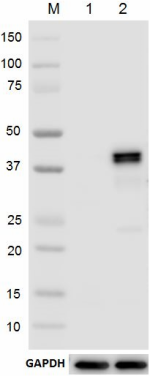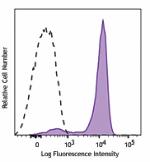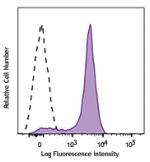- Clone
- 4B11B69 (See other available formats)
- Regulatory Status
- RUO
- Other Names
- P44/42 MAP (motogen activated protein) Kinase, Extracelluar signal-regulated kinase (ERK)
- Isotype
- Mouse IgG2b, κ
- Ave. Rating
- Submit a Review
- Product Citations
- publications

-
15 µg of total protein extract from Jurkat cells treated with PMA was resolved by electrophoresis, transferred to a nitrocellulose membrane, and probed with Direct-Blot™ HRP anti-ERK1/2 Phospho (Thr202/Tyr204) (clone 4B11B69). Proteins were visualized using chemiluminescence detection.
| Cat # | Size | Price | Quantity Check Availability | Save | ||
|---|---|---|---|---|---|---|
| 675506 | 25 µL | £70 | ||||
| 675505 | 100 µL | £233 | ||||
ERK1/2 are members of mitogen-activated kinases (MAPKs) of serine/threonine protein kinases. ERK1/2 can be activated by a range of extracellular stimuli, such as mitogen, growth factors, neurotransmitters, chemokines, and cytokines, through receptor tyrosine kinases (RTK), G protein-coupled receptors (GPCRs), or protein kinase C (PKC). Upon stimulation, ERK1/2 are phosphorylated by the upstream kinase MEK on residues Thr202 and Tyr204 and in turn phosphorylate many other downstream molecules that are involved in a range of cellular processes such as cell proliferation, differentiation, motility and cell death.
Product DetailsProduct Details
- Verified Reactivity
- Human, Mouse
- Antibody Type
- Monoclonal
- Host Species
- Mouse
- Immunogen
- Synthetic peptide (TGFLT*EY*VATRC) conjugated to KLH.
- Formulation
- This antibody is provided in 50% glycerol in aqueous buffered solutions with preservatives.
- Preparation
- The antibody was purified by affinity chromatography and conjugated with HRP under optimal conditions.
- Concentration
- Lot-specific (to obtain lot-specific concentration and expiration, please enter the lot number in our Certificate of Analysis online tool.)
- Storage & Handling
- Upon receipt, the antibody solution should be stored undiluted at -20°C, and protected from prolonged exposure to light.
- Application
-
WB - Quality tested
- Recommended Usage
-
Each lot of this antibody is quality control tested by Western blotting. For Western blotting, the suggested dilution is 1:1000-1:2000. The optimal dilution should be determined by titration for each individual assay of interest.
25 µl and 100 µl of Direct-Blot™ HRP antibody can be used for approximately 5 and 20 Western blots, respectively, at the recommended concentration/dilution. - Product Citations
-
- RRID
-
AB_2566700 (BioLegend Cat. No. 675506)
AB_2566700 (BioLegend Cat. No. 675505)
Antigen Details
- Structure
- ERK1 and ERK2 encode 42 and 44 kD protein kinases and share 85% homology.
- Distribution
-
Cytoplasm. Nucleus.
- Function
- ERK1/2 are broadly expressed protein kinases that are involved in proliferation, differentiation, motility, and cell death. In response to extracellular stimuli, ERK1/2 are phosphorylated at Thr202 and Tyr204 and in turn transduce signals to downstream substrates.
- Interaction
- ERK1/2 phosphorylates a wide range of downstream substrates, such as ATF2, BCL6, EIF4EBP1, CANX, MAP2, DAPK1, RAF1, SYK, and GRB10.
- Biology Area
- Cell Biology, Neuroscience, Signal Transduction, Synaptic Biology
- Molecular Family
- Postsynaptic proteins, Phospho-Proteins, Protein Kinases/Phosphatase
- Antigen References
-
1. Futran AS, et al. 2013. Curr. Biol. 23:R972.
2. Mendoza MC, et al. 2011. Trends Biochem. Sci. 36:320.
3. Chambard JC, et al. 2007. Biochim. Biophys. Acta. 1773:1299.
4. Roux PP, et al. 2004. Microbiol. Mol. Biol. Rev. 68:320.
5. Torii S, et al. 2004. J. Biochem. 136:557.
6. Clark EA, et al. 1996. J. Biol. Chem. 271:14814. - Gene ID
- 5594 View all products for this Gene ID
- UniProt
- View information about ERK1/2 on UniProt.org
Related Pages & Pathways
Pages
Other Formats
View All ERK1/2 Reagents Request Custom Conjugation| Description | Clone | Applications |
|---|---|---|
| Purified anti-ERK1/2 Phospho (Thr202/Tyr204) | 4B11B69 | WB,ICC |
| Direct-Blot™ HRP anti-ERK1/2 Phospho (Thr202/Tyr204) | 4B11B69 | WB |
| Alexa Fluor® 647 anti-ERK1/2 Phospho (Thr202/Tyr204) | 4B11B69 | ICFC |
| Alexa Fluor® 488 anti-ERK1/2 Phospho (Thr202/Tyr204) | 4B11B69 | ICFC |
Compare Data Across All Formats
This data display is provided for general comparisons between formats.
Your actual data may vary due to variations in samples, target cells, instruments and their settings, staining conditions, and other factors.
If you need assistance with selecting the best format contact our expert technical support team.
-
Purified anti-ERK1/2 Phospho (Thr202/Tyr204)

Total cell lysates (15 µg protein) from Jurkat cells without... 
Untreated (left) and PMA-treated (20 nM PMA treatment for 10... -
Direct-Blot™ HRP anti-ERK1/2 Phospho (Thr202/Tyr204)
15 µg of total protein extract from Jurkat cells treated wit... -
Alexa Fluor® 647 anti-ERK1/2 Phospho (Thr202/Tyr204)

Human peripheral blood lymphocytes were stimulated with (fil... 
C57BL/6 mouse splenocytes were stimulated with (filled histo... -
Alexa Fluor® 488 anti-ERK1/2 Phospho (Thr202/Tyr204)

Human peripheral blood lymphocytes were stimulated with (fil...
 Login / Register
Login / Register 









Follow Us